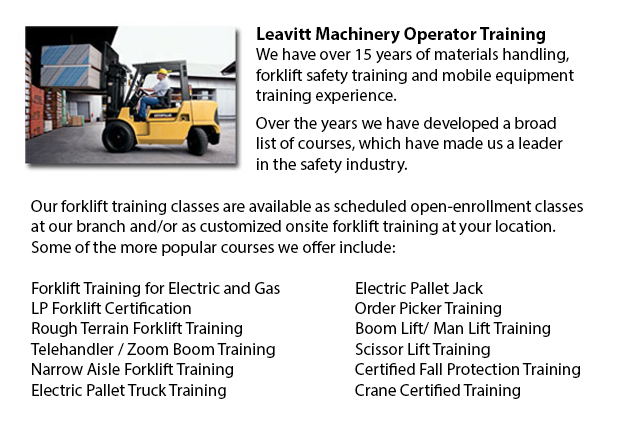
Burlington Forklift Training Schools - Forklift Training Schools - The Very Best Option To Have An Efficient And Safe Work Area
Are you searching for a job as a driver of a forklift? Our regulatory-compliant mobile equipment operator training offers instruction in kinds of forklifts, pre-shift check, fuel types and dealing with fuels, and safe utilization of a lift truck. Practical, hands-on training assists participants in acquiring basic operational skills. Program content includes existing rules governing the operation of forklifts. Our proven forklift Schools are intended to provide training on these types of trucks: powered pallet truck, narrow isle forklift and counterbalanced forklift.
When the lift truck is in use, do not raise or lower the forks. Loads must not extend above the backrest. This is because of the possibility of the load sliding back in the direction of the operator. Check for overhead obstructions and make sure there is plenty of clearance before raising a load. Stay away from overhead power lines. Once the load is raised straight up, tilt it slightly back.
The lift truck is less stable when a load is in a raised position. Ensure that no one ever walks below the elevated fork. The operator should never leave the forklift when the load is raised.
When handling pallets, forks must be high and level enough to go into the pallet and extend all the way beneath the load. The width of the forks must provide even weight distribution.
Chock the wheels and set the brakes prior to unloading and loading the truck. The floors must be strong enough to support the weight of both the forklift and its load. Fixed jacks could be installed to be able to support a semi-trailer which is not coupled to a tractor. The height of the entrance door should clear the forklift height by a minimum of 5 cm. Edges of docks, rail cars and ramps should be marked and avoid them.
-
Burlington Manlift Operator Certification
Burlington Manlift Operator Certification - Our aerial lift and scissor platform certification and training empowers those participating with a general understanding and knowledge of the safe and efficient use of "Power Operated Mobile Work Platforms... More -
Skid Steer Loader Training in Burlington
The engine powered skid-steer loader consists of a small and rigid frame, equipped along with lift arms that could connect to several industrial attachments and tools in order to execute numerous labor saving jobs. Typically, skid-steer loaders are f... More -
Burlington Manlift Training
Burlington Manlift Training - Different manlift training courses consist of the review and content of manlift devices. An important portion of the program is the practicum where students show their knowledge and practical ability to safely operate a... More -
Burlington Overhead Crane Ticket
Burlington Overhead Crane Ticket - The overhead crane is a common heavy equipment used in industrial environments. This particular equipment is known as a bridge crane and consists of parallel runways spanned by a traveling bridge. The part that lift... More -
Burlington Forklift Training Programs
Burlington Forklift Training Programs - If you are looking for work as an operator of a forklift, our regulatory-compliant forklift training programs provide exceptional instruction in various types and styles of lift trucks, lessons on pre-shift che... More -
Burlington Boom Lift Safety Training
Burlington Boom Lift Safey Training - Boom lifts are a kind of aerial lifting device or elevated work platform which are usually used in industry, warehousing and construction. Boom lifts can be utilized in almost whichever surroundings because of th... More -
Burlington Manlift Ticket
Burlington Manlift Ticket - The Manlifts and Elevated Platforms program provides training on the regulations, rules and proper application of safe operating measures and work practices involved in everyday activities for people who work with this equ... More -
Burlington Scissor Lift Training
Burlington Scissor Lift Training - Scissor lifts need to be operated proficiently to be able to protect the safety of the machinery and the safety of people in the workplace. Skilled operators are trained to drive the specific class of scissor lift f... More

Forklift Certification Burlington
TOLL FREE: 1-888-254-6157
Burlington, Ontario
forkliftcertificationburlington.com
Email Us
About Us


